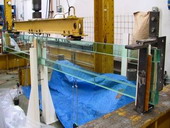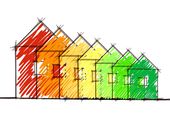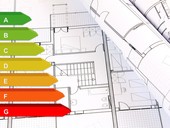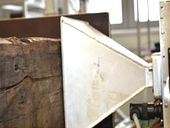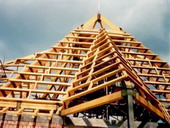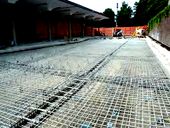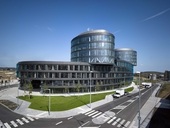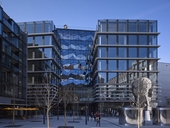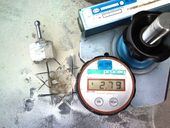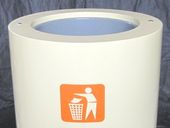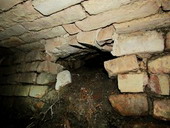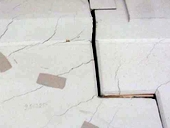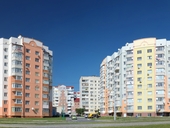Transparency and also smooth, glossy and reflective glass surface give special importance of this material in the contemporary architecture. Connections between two glass elements or glass pane and other part from a different material are very important issue for structural applications of glass. Moreover, there are many types of hybrid structures that combine glass and different materials to achieve safe failure behaviour and high degree of transparency at the same time. Connection of brittle glass and reinforcing material is an essential part of these structures, where composite action between two parts is beneficially ensured by a glued joint. Experimental determination of mechanical characteristics of various adhesives applied in planar connections under shear loading is a main topic of current paper.
Archiv článků od 2.11.2015 do 11.1.2016
Elaboration up the full report is a complex process which is necessary to define the cost optimum for individual member states.The general procedure for determining cost optimization consists of four basic steps under Delegated Regulation. 244/2012: Determination of the reference buildings, determination of measures for improving energy efficiency, calculation of primary energy and calculation of the total cost.
Cost-optimal levels of Member States, to be set according the comparative methodology framework of the European Commission Delegated Regulation 244/2012 and the guidelines accompanying Delegated Regulation to national parameters. European Commission makes the claims for all Member States to report on about cost-optimal levels for their particular country and compare them with national requirements were based on regulations.
This paper presents methods to enhance the punching shear resistance of existing flat slabs (enlargement of supported area, enhancement of flexural resistance of slab, post-installed shear reinforcement and prestressed solutions). In case of post-installed shear reinforcement, systems based on steel and CFRP are mentioned. Static, technological and economic advantages and disadvantages are analysed. Differences between the systems are mainly due to the requirement to access the upper face of the slab, resistance-decrease in case of fire and deformation capacity of the strengthened slab.
The paper presents an overview of preservation methods based on professional, expert assessment and research activity of the Thermal Preservation Methodological Department. It reflects the suitability and usability of available methods for wooden elements of respective type of structure. The methods are represented according to currently available and applied preservation methods. The methods use thermal energy, namely the hot-air sterilisation of wood and microwave technologies. The presented paper specifies conditions under which the methods shall be used so that their application contributes to more efficient protection of the heritage fund. The field of biotic harmful elements includes wood-destroying insects and fungi with special regard to dry rot fungus (Serpula lacrymans).
Wood in all its forms and versatility of its use is closely linked with the existence and development of human society. Interest in building timber structures is increasing nowadays. Structures are designed from both traditional timber and from new wood-based materials and connectors. This trend is positively reflected, among other things, in the growing numbers of students choosing timber and wood-based structures for their high-quality bachelor and diploma theses.
One of the most vital criteria in assessing any building structure is monitoring their real behaviour during a long-term use. The aim of the paper is to review data and conclusions from the monitoring in some types of building structures that the authors designed either themselves or participated in their design and development.
The corrosion of steel reinforcement is the most important factor in degradation of the concrete structures. The use of the new composite materials as reinforcement in concrete structures has expanded in recent years. These concrete structures are often exposed to extreme environmental loads. The fibre reinforced polymer (FRP) materials are an alternative to the steel reinforcement. It is a durable material, which has corrosion resistance, high tensile strength and low density. The manufacturers use various kinds of fibers in the FRP reinforcement, especially carbon (CFRP), glass (GFRP), aramid (AFRP) and basalt (BFRP). The present article describes the application of the FRP reinforcement as a replacement of the steel reinforcement in new structures, respectively for strengthening of existing concrete structures.
In early September, the administration building Aviatica was inaugurated and officially unveiled, which is the flagship of a large development in the former factory Walter in Prague. Use of abandoned industrial sites, called Brownfields has been the great theme of Planning and Development during the last few years. Vast territories with dilapidated buildings have a negative impact on their environment, in terms of the degradation of the environment, environmental stress, negative social phenomena or reduction of the economic potential of the site. These lucrative localities are connected to existing technical and transport infrastructure. The transformation has a positive impact on the surrounding areas and instead of spatial expansion of cities into the countryside is one of the ways to exploit their intrinsic potential.
The paper presents a methodological procedure and results of acoustic detection of wood-destroying insect larvae in the buildings of the Wallachian Open Air Museum in Rožnov pod Radhoštěm. Using the Acoustic Pack acoustic system, the activity was monitored at 112 positions of wooden trusses of framing on the house of Prlov and Rožnov Town Hall as structures considered for the performance of a preservation measure. Based on the obtained results, the actual status of active infestation of wooden elements was defined with the graphic output of activity and sound records which will be used for designing efficient preservation of the structures.
In October 2015, it was one year from when the new polyfunctional building Quadrio in the center of Prague above the metro station Národní třída was opened. It incorporates not only business and office space, but also residential building, a public passage and exit from the metro station. After almost thirty years a big scar of the historic city was healed. It was caused by the construction of the metro station Národní třída, which was accompanied by the demolition of the original buildings and the replacement with single-storey ground lobbies that suit rather to the suburb than the city center. At the same time a new public urban space was created, a stone plaza, which is in the case of similar projects rather rare exception than the rule.
Methods of cost allocation in apartment buildings have undergone significant changes in recent years. The article offers a comprehensive overview of cost allocation methods in multi-dwelling units according to applicable regulations. It is intended mainly for owners of residential units, board members of homeowners associations, managers of housing cooperatives or individuals and companies managing residential buildings.
Cost allocation in apartment buildings is currently governed by two laws: Act No. 67/2013 Coll. and the new Civil Code No. 89/2012 Coll. These laws governed cost allocation in calendar year 2014 and apply also for 2015. The heating and hot water supply costs in MDUs from 2016 onwards will be allocated pursuant to the new decree No. 269/2015 Coll. and the amended Act No. 67/2013 Coll.
The second part of the article describes specific aspects of the construction as the subject of the Contract for work and materials. It looks into ownership issues of the construction – the subject, the execution of the construction and its possible defects. It carries on to contextually analyze specific problems, like the transfer of risk of damage, right to invoice, inspection of subject progress, hidden obstructions and construction handover and acceptance. It also outlines the issue of joint responsibility of a subcontractor for construction defects.
This paper proposes statistical methods for evaluation quantitative performance determinated by tests of building products for objective decision during conformity assessment / certification in a fire protection field. The procedure is applicable for other types of products, and research / development of new material products.
Concrete exposed to high temperature considerably changes its properties down to total destruction. The paper describes renovation of concrete floor damaged by a fire of a factory building. Individual steps of determination of damage of concrete floor structures caused by high temperatures are described. Structure of damaged floor was technically analyzed, redevelopment was designed and renovation works were carried out.
Research, development and testing of materials and safety features used to protect civilians and armed forces against terrorist or military attacks are more than desirable nowadays. Therefore, our work is aimed at absorption materials that can temper impact energy and shockwave energy originating in explosive blast.
Out of many materials potentially suitable for experiments, two groups of fillers were chosen – macro fillers and micro fillers – and a two component polyurethane binder. In this article, the resulting physico-mechanical characteristics are summarized: bulk density, flexural, compression and impact strength. The crucial test for determination impact energy absorption was the Split-Hopkinson pressure bar test, conducted with most samples.
The basement of a castle greenhouse, so called catacombs, and a terrace with air shafts above them are located to the east by the Palm greenhouse of a state castle Lednice and they are connected with it. Catacombs used to serve as depositaries for storing plants from castle park in a period of winter month. Preservation of greenhouse’s catacombs began in 2004 and was carried out in phases till the end of 2007 when the work was interrupted. In 2012 the investor decided to proceed to finish the second part of a planned reconstruction connected with a reconstruction of basements under the greenhouse terrace. The vital part under the project documentation is also dealing with a rehabilitation of damp masonry including necessary constructional and technical research with respect to dampness and its elimination.
Revision of ETAG 004 brought a change in the assessment of noise protection external thermal insulation composite systems (ETICS). Under this revision ETICS may have positive or negative influence on airborne sound insulation of wall on which was applied. The article deals with calculation method of airborne sound insulation, including concrete calculations, and measurements on ETICS with mineral wool.
The introduction of energy management according to ČSN EN ISO 50 001 becomes a topic that attracts more and more attention of involved people nowadays. There are two reasons for that. The first one is the possibility of obtaining a higher subsidy from the OP PIK, the second is the obligation by the law, respectively the possibility of reducing the administration in the future.
Buildings which are issued to natural changes of atmospheric temperature, should be divided to parts that can act independently. If not, the structure itself will be split up according to the general laws of physics and the internal and external form and material properties of the structure. The article describes failures of expansion joints of constructions.
The article gives information on the requirements of sunlight in buildings in the European Union and gives a brief historical overview of the normalization of sunlight in our country. On the concrete realization of the residential complex built around 2000 in a closed blocks line is demonstrated the satisfactory insolation in these conditions. From this perspective provides a comment on current events about the preparations of Prague building regulations.
zpět na aktuální články
